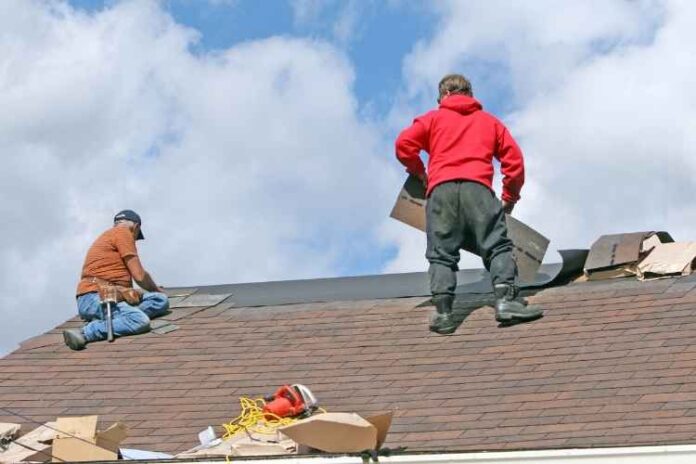Replacing your roof is a huge project, but it’s one that you can definitely do yourself with the right knowledge. In this post, we’ll go over the 20 basics of roofing replacement so that you’ll know what to expect and be able to tackle the job with confidence. Whether you’re replacing a few shingles or doing a full tear-off and rebuild, these tips will help make the process easier. So let’s get started!
1. Assess the Damage
Before you do anything, it’s important to take a good look at the damage and figure out what needs to be done. Sometimes a few shingles can be replaced without doing any major work, but other times the entire roof needs to be replaced. If you’re not sure, it’s always best to consult with a professional to get an accurate assessment.
2. Get Prepared
Once you know what needs to be done, it’s time to start getting prepared. This includes gathering the materials you’ll need as well as making sure you have enough space to work. You’ll also want to make sure that you have safety gear like a hard hat, safety goggles, and gloves so that you can stay protected while working.
3. Remove the Old Roofing
Whether you’re just replacing a few shingles or doing a full tear-off, you’ll need to remove the old roofing material before you can install the new one. This can be a messy and time-consuming process, so it’s important to take your time and do it carefully. Be sure to dispose of the old roofing properly so that it doesn’t end up in a landfill. If you are finding it overly complicated, you can always get in touch with a professional roofing contractor.
4. Install the New Roofing
Now it’s time to install the new roofing material. If you’re doing a complete replacement, this will involve putting down a layer of felt paper before installing the shingles. Make sure to follow the manufacturer’s instructions carefully so that you get a good seal and the roof lasts for as long as possible.
5. Finish Up
Once the new roofing is in place, it’s time to finish up. This includes trimming any excess material, sealing any seams, and installing any vents or other accessories. Be sure to clean up the work area well so that there’s no chance of anything going wrong later on.
6. Inspect the Roof Regularly
It’s important to inspect the roof regularly, especially after severe weather. This will help you catch any problems early on so that they can be fixed before they cause major damage. Be sure to keep an eye out for any loose shingles, cracks, or other signs of wear and tear.
7. Know When to Call a Professional
There are some roofing projects that are best left to the professionals. If you’re not comfortable doing the work yourself or if the damage is too extensive, it’s always best to call in a professional. They’ll have the experience and expertise to get the job done right and make sure that your roof lasts for years to come.
8. Get a Warranty
When you hire a professional to do the roofing work, be sure to get a warranty on the job. This will protect you in case there are any problems with the roof down the line. It’s also a good idea to read the warranty carefully so that you know what is and isn’t covered.
9. Keep it Clean
One of the best ways to keep your roof in good condition is to keep it clean. Be sure to clear away any leaves, branches, or other debris from the roof regularly so that water can drain properly and there’s no chance of mold or mildew growth.
10. Use Roofing Sealant
If you’re using asphalt shingles, it’s a good idea to use roofing sealant. This will help keep the shingles in good condition and protect them from the elements. It’s a quick and easy way to extend the life of your roof.
11. Avoid Walking on the Roof
It’s important to avoid walking on the roof, especially if it’s wet or icy. This can damage the roofing material and make it more susceptible to leaks. If you need to get up there for any reason, use a ladder instead of walking on the roof.
12. Get a Roof Inspection
If you’re not sure whether or not your roof needs replaced, it’s a good idea to have it inspected by a professional. They’ll be able to tell you if the roof is in good condition or if it needs to be replaced. This can save you a lot of time and money in the long run.
13. Don’t Wait to Replace the Roof
If your roof is damaged, don’t wait to replace it. The longer you wait, the more damage will be done and the more expensive it will be to fix. Be sure to call a professional as soon as you notice any problems so that they can get started on the repairs right away.
14. Consider Replacing the Gutters
If your gutters are old or damaged, it’s a good idea to replace them at the same time as your roof. This will help ensure that your home is protected from water damage and that the roof lasts for as long as possible.
15. Get a Professional Opinion
If you’re still not sure whether or not you need to replace your roof, it’s a good idea to get a professional opinion. They’ll be able to take a look at your roof and give you an honest assessment of its condition. This can help you make the best decision for your home and budget.
16. Consider the Cost
Replacing a roof is a big investment, so it’s important to consider the cost before making any decisions. Be sure to get estimates from several different contractors so that you can compare prices. You should also factor in the cost of materials, labor, and any other associated expenses.
17. Choose the Right Material
When choosing a material for your roof, be sure to consider your climate and the type of home you have. Some materials are better suited for warmer climates, while others are better for colder climates. You should also take into account the cost and durability of each material.
18. Get a Roof that Fits
It’s important to choose a roof that fits your home. If you choose a roof that’s too big or too small, it won’t look right and it may not be as functional as it could be. Be sure to consult with a professional before making any decisions so that you can get the best possible results.
19. Hire a Professional Contractor
When hiring a contractor, be sure to ask for referrals and read reviews online. This will help you find a contractor that you can trust and that will do a good job. It’s also important to get a written estimate from the contractor before they start the work so that you know what to expect financially.
20. Follow These Tips
Following these tips will help you choose the right roofing material, get a good warranty, and make sure the job is done properly. By taking these steps, you can ensure that your roof lasts for many years to come.
If you’re in need of a new roof, be sure to follow these tips! They’ll help you make the best decision for your home and budget. Replacing a roof can be a big investment, so it’s important to consider all of your options before making a decision. For more information on roof cleaning be sure to visit Bax Clean.


























